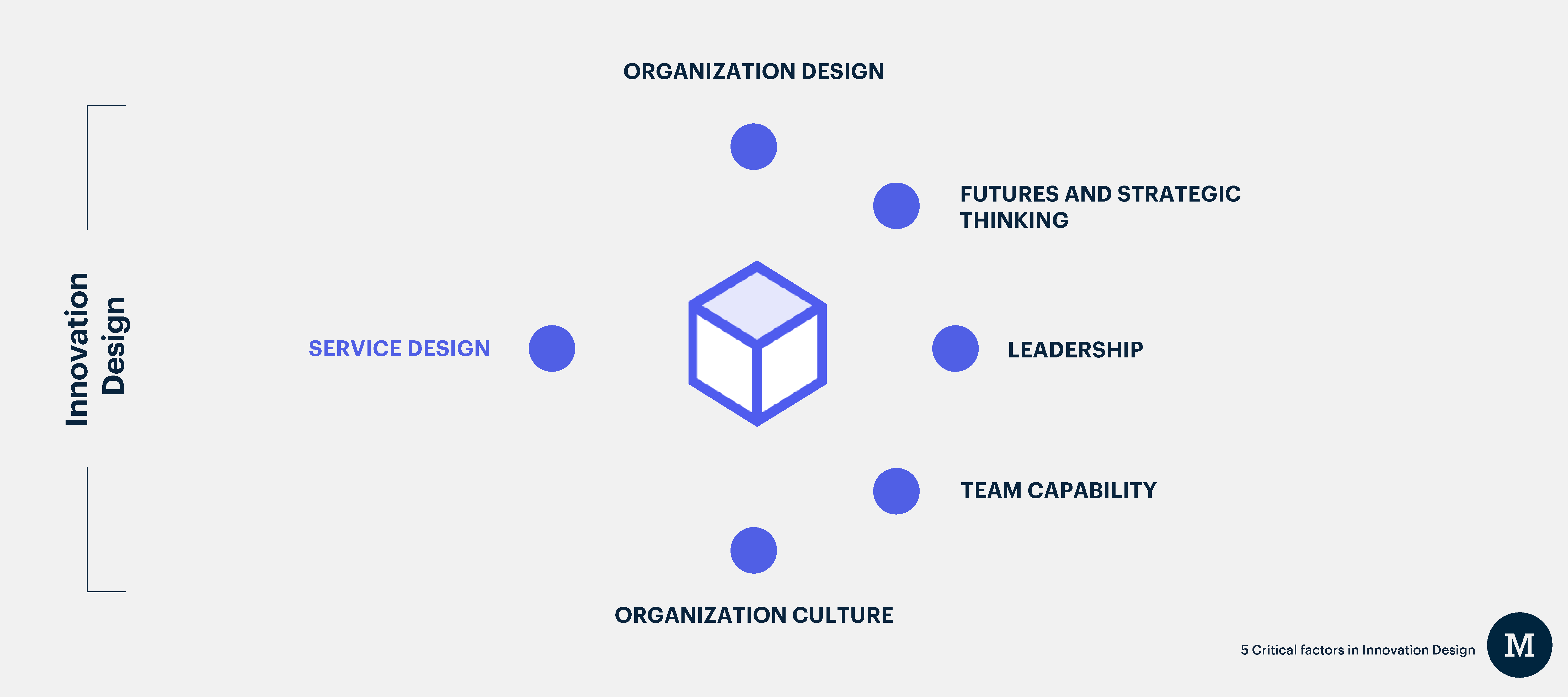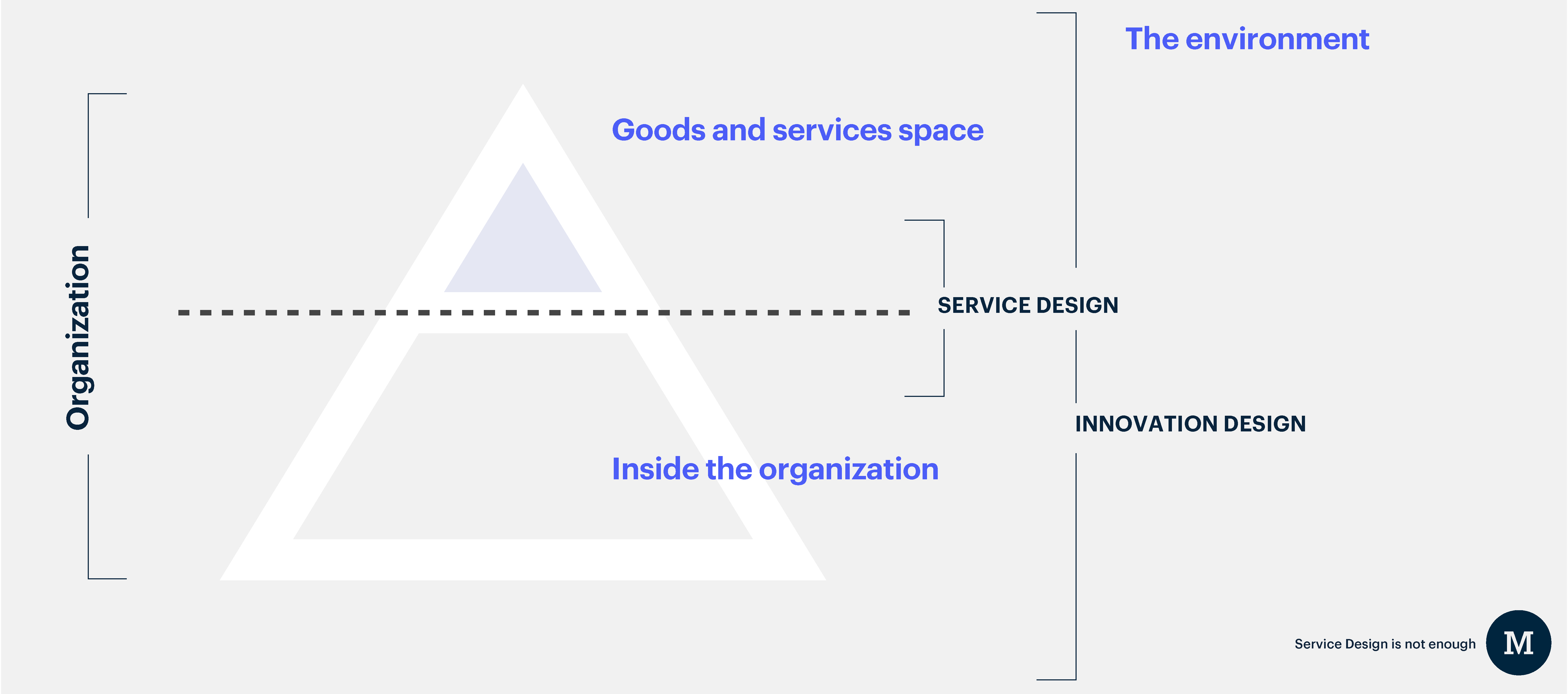If you’re just using Service Design to innovate, you’re missing the bigger picture.
Service Design is essential for organizations to approach their business as a service. It helps companies move towards Innovation. But it’s not enough.
Recent experiences have shown me that it is not easy—nor effective—to transpose learnings from Service Design projects into other domains, nor to integrate the solution(s) into the wider systems of the organization. The application of some design outcomes, although inspiring and potentially incrementally effective, doesn’t often lead to the results an organization really needs.
I say this because the interest in Service Design and scope of its work mostly focuses on the design of the service and the capabilities to deliver it, rather than the context and the ability of an organization to innovate.
How can the outcomes of Service Design work survive and thrive if the context in which it lives is not “innovating” as well?
Service Design ≠ Innovation (necessary, but not sufficient).
Service Design is at the forefront of Innovation today. It emerged as a new generation of designers began to apply methods and processes from various disciplines of design, management, and social sciences to design services and their often intangible experiences. The discipline continues to grow as the complexity of challenges organizations face increases, and the transformation to an experience economy progresses.
Alas, Service Design on its own will not move the needle on Innovation within traditional and often change resistant organizations. Not because it isn’t an important piece of the puzzle, but because Service Design on its own is not sufficient.
The complex, dynamic, and systemic nature of the problems we are—and will be—facing requires a radically different response than the little tinkering or incremental problem solving organizations are willing to explore and implement. I can illustrate with a few examples from my lived experience as a practitioner, but here’s a timely conversation that represents a problem with its multidimensions:
According to the latest research from the Mobility, Logistics, and Automotive Technology Research Centre at the Free University of Brussels (VUB), a battery-powered electric vehicle that uses electricity generated by fossil fuels will emit slightly more emissions over its lifetime than a diesel-powered car—still less than a gasoline-powered car. But e-cars that use electricity produced from renewable sources will produce up to six times less carbon emissions over their lifetimes than a gasoline-powered car. This means that in order for the switch to e-mobility to be most effective, countries will have to transition their energy generation in parallel.
It’s not enough to explore electric vehicle batteries without addressing its dependencies and implications. The system has to support the proposed solution experience, and vice versa.
Innovation Design focuses not only on the generation of solutions within a defined sandbox but also on the ability to create new approaches to the problem situation itself, addressing the problem at its root core—which may lay beyond the service space—and the system to which it belongs.
Above, Simon Mhanna speaks with Marc Fonteijn on the Service Design Show about overcoming organizational challenges associated with delivering Service Design work with real impact, based on ideas shared in this post.
What is Service Design?
Service Design is all about putting people at the heart of the experience and taking a holistic approach to problem solving and co-creating the future. As Birgit Mager defines it: “Service Design aims to ensure service interfaces are useful, usable, and desirable from the client’s point of view and effective, efficient, and distinctive from the suppliers point of view.”
Service Design is a key enabler to humanize products and experiences and to create a better future for the stakeholders involved in the process.
A new business imperative on the rise—the approach to provide “everything” as a service to consumers—is driving core revitalization efforts within organizations that are now adopting Service Design to bring customer centric mindsets into the organization. Service Designers work on equipping organizations with the thinking, tools, and processes of Service Design so that you can drive Innovation in the conception, design, and delivery of services and service experiences.
So what is Service Design missing? Next level thinking.
The limited focus of Service Design does not address the transformation work needed to shift the conditions in which the disciple operates. Innovation requires an integrated approach that tackles relationships, and interdepencies and implications beyond the design of the service itself.
Definition of Innovation.
Innovation is an overused and popular term. It’s now at a point where some business leaders and professionals cringe when they hear it. The problem is that it can mean anything and everything.
I believe that it is important to start with a solid definition for alignment, so here is how we speak about Innovation at The Moment:
The Moment’s definition of Innovation: Innovation is the process in which a new idea or invention is translated into a good or service that creates value or for which customers will pay.
To qualify as Innovation, an idea must create value, be replicable and scalable at an economical cost, and must satisfy further an existing need or address an emerging one.
Innovation also involves novel ways of using resources and human-centered processes by which the idea is generated, developed, and implemented. It also requires the involvement of key stakeholders along the journey.
So if Service Design focuses on the design of goods and services inside and outside the organization (because Service Design could also be applied to designing employee experience, for instance), Innovation Design takes it a few steps further. Additionally, Innovation Design looks at the underlying patterns of the system, conditions, and relationships (including models of decision making and governance), capabilities, resources, and resilience to enable the emergence, responsiveness, and wellbeing needed for the transformation of the organization. And it’s done with the intention of framing its impact on ALL stakeholders.
As you address new products, services, technologies, and processes, you need to be building the foundations that ignite, fuel, and sustain your innovation work.
What is Innovation Design?
Innovation Design draws from diverse fields of practice: human-centered design, business strategy, research, systems thinking, leadership, organizational change, and learning.
Innovation Design is not just about coming up with new ideas and products— it’s also about all the changes required to enable sustainable organizational growth, market differentiation, and people’s wellbeing.
As you address new products, services, technologies, and processes, you need to be building the foundations that ignite, fuel, and sustain your innovation work.
As you are addressing new products, services, technologies, and processes, you need to be building the foundations that ignite, fuel, and sustain the innovation work.
5 critical factors in Innovation Design.
Here are 5 factors that show why Service Design is not enough if you want to be truly Innovative:

The five critical factors to enable Innovation Design
1. Organization culture.
Your organizational culture is critical to Innovation work and the investments you make in Innovation. Does your culture help propel you into the future? Or does it hold you back at the status quo? Culture is made up of the factors and conditions that enable Innovation work. Simply put: “the way we do things around here” will either help or hinder your Innovation work, so it’s best if you know which it is.
Your culture is where the Service Design work takes place. It needs to allow “the new” to come to fruition, and it needs to support it to thrive. Without new, fresh thinking and healthy behaviours you won’t be able to realize that desirable future.
Innovation Designers support the shift towards cultural conditions that nurture Innovation. They are change agents, fully aware that organization cultures are powerful creators of great things, and blind destroyers of things that don’t “fit.” They don’t shy away from addressing the entire cultural aspects of Innovation because without a culture that supports Innovation, efforts often become futile.
2. Futures and Strategic Thinking.
We are witnessing and participating in a fundamental transformation in the world around us. Automation, Blockchain, Artificial Intelligence, and Machine Learning are changing the nature of the game. These significant changes raise enormous organizational challenges—and opportunities.
If organizations want to thrive, they not only have to stay on top of trends, but also ahead of the market. It’s easy to read reports, sense into changes, and integrate available technology; the more difficult part is putting those ideas into actions and steering the organization towards new horizons.
As we wrestle with these unparalleled disruptions, and economic and societal shifts, Innovation Designers leverage systems thinking, foresight expertise, and strategic business lens. They ground the Service Design work in defined alternative possible futures, to open future-focused problem finding, and to inform strategic options for organizations beyond immediate wins and the product/service space. They additionally transition and transform the business as a whole—as opposed to its components separately (goods and services)–into the future.
3. Innovation leadership.
Innovation work entails a culture that promotes experimentation, risk-taking, and learning. It requires leaders and employees to push themselves and the organization out of their comfort zones to create the conditions and incubate behaviours and tools to facilitate the transitions from “fear-based” to “bravery-based” approaches to the work.
Without this necessary transition, Service Design work gets stuck. We can all think of examples of projects that didn’t go beyond the early prototyping phase because the solution didn’t seem easy to try.
Innovation Designers are equipped to create a safe space for leaders and employees to explore new ideas. They hold the organization accountable to its commitment to innovate and support its people to overcome the fear of criticism and reprisals for mistakes, and to promote informed risk tolerance and create a new system of feedback and rewards based on desired behaviours that support the pursuit of organization purpose.
4. Team capability.
Navigating the complex nature of Innovation work requires teams engaged in the process to learn and build new capabilities. Innovation Designers have a great ability not only to guide and support teams and leaders through Innovation challenges but to design programs and activities aimed at explicitly building Innovation capabilities. These capabilities set us the organization to sustain the innovation work and enable the Service Design work to come to fruition.
Defining and measuring critical competencies for Innovation throughout the organization becomes an embedded system that integrates with the work, the projects benefit from increased understanding of the practice and the rigueur brought into the work, and the learning accelerates with the ability to apply the learning in practice. We call this learn by doing, and The Moment has helped numerous companies build and scale their Innovation teams in just this way.
5. Organization Design.
Organizations that are serious about promoting Innovation efforts commit to create a dynamic and self-aware sense of leadership across their teams. They create an environment where everyone is invited—and enabled—to participate and engage in leadership. In this new model, everyone is driving their work, and the work of their organization, to achieve a greater purpose.
In order to help the organization get to this level of self-management, Innovation Designers attend to the needs of the organization to reinvent itself and embrace new ways of being, working, leading, and organizing. Through this work, Innovation Designers bring an ability to design, deliver, and coach others in organization change programs. They assist leaders making in making critical decisions, and they willingly and masterfully lend an ear to the people going through the change. Above all, no matter where you sit within the organization, they are able to empathize with, and empower everyone, to make the leap.
Innovation is more than incremental improvements; it’s bold moves that require foresight and functioning application.
Innovation as a system.
Within the increasing interest in Service Design, and the often aggressive demand for design solutions focused on immediate wins across industries, lies an opportunity to bring to light the importance of understanding Innovation as a system.

While organizations have become more conscious of addressing emergent trends and human-centered needs, and including them in strategic planning, the main focus remains on incremental Innovation—one tweak here, one solution there. Innovation is more than incremental improvements; it’s bold moves that require foresight and functioning application.
It’s clear today that more needs to be done to invest in an Innovation portfolio approach for many organizations. The appetite for Service Design may be the Trojan Horse to invite more in-depth conversations and to nudge the required transformational Innovation work forward to create a lasting impact inside and outside the organization.
If service design isn’t enough, what is?
Innovation Designers design and facilitate relationships and experiences across the organization and beyond, to enable service delivery and product development, and to create value for all stakeholders. They partner with teams across departments to improve customer and employee experiences, incubate new products and services, and cultivate a human-centered design culture and Innovation capability internally.
To be successful in Innovation, you must take a systematic approach: to understanding the organization as a whole, and the environment within your Innovation system will operate. You must apply Innovation Design tools to many diverse challenges and contexts in the organization, and develop skills in moving the needle on Innovation holistically, shaping the organization and its conditions to be the most conducive for the Innovation work on the services level. Do so, and you will see better outcomes that stick, and an organization that becomes Innovative itself along the way.
Stay up to date with monthly Innovation insights.
Join our monthly newsletter to stay informed with news, inspiration, and practical advice from The Moment and around the web to build your innovation practice.








